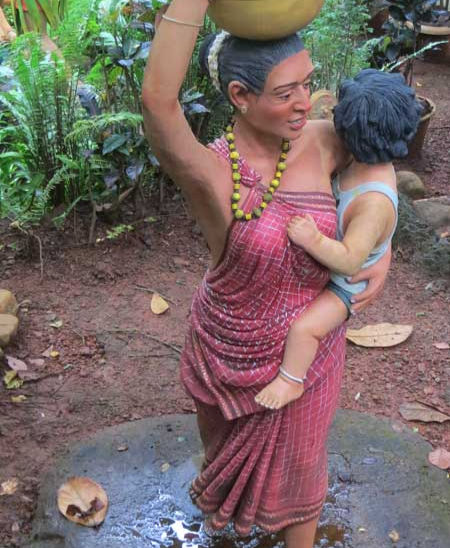Kunbi Saree: How Goa’s Oldest Saree Survived Colonial Laws?
- gaurisawhney55
- Oct 31
- 3 min read
Before Goa became synonymous with beaches and feni, it was a land of farmers and the Kunbi saree was their identity. The name itself tells the story: “Kun” meaning people and “Bi” meaning seeds together, “those who germinate many seeds from one seed.”
True to its name, this saree was born from the earth, worn by women who nurtured it, and dyed with the very soil they worked on. Long before Portuguese ships touched Goan shores, the Kunbi saree had already wrapped generations of tribal women the Kunbis and Gaudas in its red-checked folds.

Soil, Sweat, and Symbolism
The Kunbi saree isn’t just a garment; it’s a living metaphor for life itself. Its vibrant red hue stands for fertility, vitality, and the heartbeat of the land. Worn during festivals and rituals, the fabric was considered pure and sacred, even offered to deities during the Veerabhadra ritual of the Shigmo festival.
The glow of the Kunbi saree doesn’t come from silk or gold it comes from the hands that wove it and the earth that dyed it.”
Designed for the Fields, Draped for Freedom
Practicality was its beauty. The Kunbi saree was woven shorter than usual about 4 to 5 yards to keep the hem above the ankles, allowing women to move freely through muddy fields. Its drape, called the ‘Dethli’, was secured with a knot on the right shoulder, needing no pins or fuss.
There was no pallu, no ornamentation just strength, comfort, and purpose. In its simplicity lay dignity. Until colonial times disrupted it. When the Portuguese arrived, they enforced a decree in the 1940s mandating women to wear a blouse a move that erased centuries of indigenous identity in a single law.

Woven from Nature, Dyed by the Earth
Every shade of the Kunbi saree comes from nature’s palette. The traditional red dye came from ‘Jafflinchi Fala’ (the Japani fruit) found in Goan forests or a mixture of iron ore, rice starch, and vinegar a perfect union of soil and skill.
Woven on a pit loom, the saree’s plain weave and coarse texture (20s–40s cotton count) made it ideal for long hours of farm labor.A subtle dobby border, often with silken threads, added a quiet touch of grace proof that beauty and function could coexist.
Colonial Decline to Cultural Revival
Goa was once a vibrant handloom hub, but colonial policies and later power looms in the 1970s pushed local weaving into silence. By the late 20th century, most Kunbi fabrics were being produced outside Goa, in Kolhapur and Ichalkaranji.
Just when the weave seemed lost, Wendell Rodricks, Goa’s celebrated fashion designer, breathed life back into it. He brought the Kunbi saree from the fields to fashion ramps, preserving its soul but adapting its form weaving it in the 6-yard modern format to suit urban tastes. His revival wasn’t just fashion it was heritage in motion.

From Rituals to Runways
Today, the Kunbi saree lives on as the costume of Goa’s famous folk dances, like the Kunbi and Fugdi, worn proudly during festivals and cultural shows. But beyond performance, it remains a powerful symbol of Goan identity a reminder of the women who tilled the soil and carried its spirit on their shoulders.
Thanks to scholars like Dr. Rohit R. Phalgaonkar, who documented and preserved its story, and to local artisans who still weave it in small pockets, the Kunbi saree continues to survive one red check at a time.
A Legacy Woven in Red
Time has softened its color and frayed its threads, but the Kunbi saree’s essence remains honest, earthy, and enduring. It’s more than fabric; it’s the heartbeat of Goa’s agrarian past, wrapped in resilience and grace. Every thread tells a story of land, labor, and legacy. The Kunbi weave is Goa’s humble way of remembering who it truly is.
At Skillinabox, we believe crafts evolve best when artisans and learners evolve together. Turn your love for traditional crafts into a career! Enroll in Skillinabox’s Fashion Design course and master cloth printing, embroidery, and more all with hands-on training from expert. Start creating today!



Comments